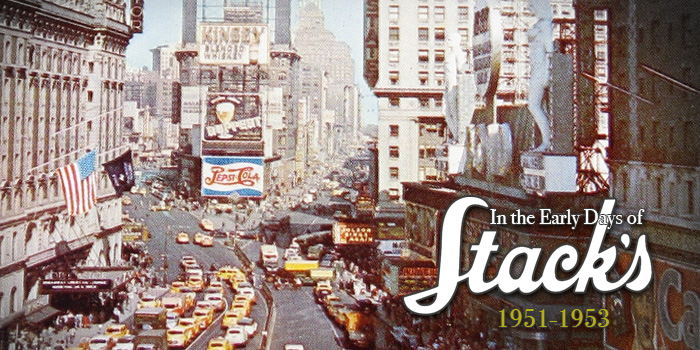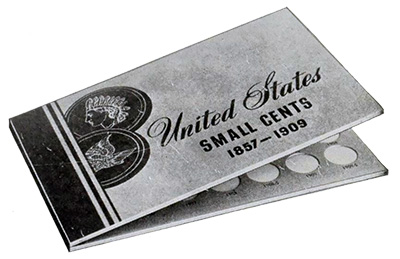
By Harvey Stack – Co-Founder, Stack’s Bowers Galleries …..
Links to Part 1 | Part 2 | Part 3
The Good Days at Stack’s in 1951
With our family staff reduced by both Norman and Ben not with us, Stack’s continued to produce its share of numismatic catalogs and price lists for United States, Ancient and Foreign coins in all metals, as well as currency. Of course we were lucky to add some new staff to help wait on the counters, fill orders, answer the phones and continue to catalog auction sales.
Yes it was a difficult time, for my Uncle Joe continued to travel and visit clients and whatever shows were about the United States. My father, somewhat handicapped, continued to focus his attention on cataloging while I went about running the shop, filling mail orders, and working to help complete catalogs for auction. The pace was a difficult one, but the results were rewarding with accomplishments.
As I wrote in an earlier series of articles, we were lucky to open a new account with Josiah K. Lilly, Chairman of Eli Lilly & Co, the famous pharmacy house in Indianapolis.
It was early Spring in 1951 when a well-dressed gentleman walked into our shop, looked about, and asked my father at the counter if we had any Spanish Colonial Doubloons in stock. He said that he had a great fondness for the sea, that he had spent much time reading the early history of the Spanish who conquered Central and South America in the early 16th through 18th centuries and wanted to own a “piece of gold” of the period.
 Morton said he had a number of different specimens in stock, and explained to Mr. Lilly that several of the Spanish-American Colonies (later to be independent countries) all issued coins during the Colonial period, as this was the way to ship gold they plundered from the natives of Central and South America.
Morton said he had a number of different specimens in stock, and explained to Mr. Lilly that several of the Spanish-American Colonies (later to be independent countries) all issued coins during the Colonial period, as this was the way to ship gold they plundered from the natives of Central and South America.
Morton first showed Lilly a portrait piece, and also a Cob, each with a face value of 8 Escudos. He also explained the the Spanish American Mints made smaller denomination in gold as well, such as the 4 Escudos, 2 Escudos and even 1 escudo. Not every one could be fortunate enough to save or earn a full 8 Escudos, but all wanted gold in their pockets, so the Mints made fractional coins.
The facts we explained were very exciting to Mr. Lilly, and he became attached to trying to build a collection, and from the assortment he was shown he selected 12 different and representative specimens, covering in essence what Morton was relating to him about Spanish American Coinage. Mr. Lilly wrote a check and asked that once it cleared could we send the gold coins to him at his office (this practice to be asked by a wealthy man to wait for the check to clear was common, for they never wanted their credit hurt in any way.)
During the visit, my father introduced Mr. Lilly to Uncle Joe and also wanted me to meet him so I could be familiar with him and his collection should he decide to continue.
Before Mr. Lilly left, we gave him a copy of Wayte Raymond’s book, Central and South American Spanish Colonial Gold. It contained a major listing of each country, each mint and each denomination that was known. It did not discuss rarity, but covered the information as a check list that a sincere collector of the series could use to determine what, up to the date of publication of the book, was know to collectors, dealers and historians who studied the series. It was amazing how many mints Spain established in the Americas, and how many different dates were struck for use in current trading, including the “Royal Fifth” that went back to the Spanish throne.
 Mr. Lilly left with a smile on his face, and commented that we would hear from him later after he returned home to Indianapolis.
Mr. Lilly left with a smile on his face, and commented that we would hear from him later after he returned home to Indianapolis.
Just before the summer, Mr. Lilly stopped into our shop in New York, as he was on his way to his summer home in Falmouth, Massachusetts. It was overlooking the sea, and he was summering looking at it. Mr. Lilly said that the history and coinage of the Spaniards in the Americas was fascinating. Could we start to assemble more of the different dates and mints to further the extent of his collection? He would stop by in the Fall to see what progress we had made and try to extend his collection of, as he liked to call it, “Pirate Gold”. That was a nice order and a great project to pursue.
The Coin Market in Our Shop
The interest in coins really started to grow in 1951 once again. The issue of Proof Sets by the Mint stimulated people to collect. The new issues of the Roosevelt Dime and Franklin Half Dollar made collecting these a bit easier. The finding of older designs of the other dates got people buying for themselves and the younger members of the family the popular Whitman Blue Coin Folder that was available for 25 Cents each and provided a great place to store coins found. The folders were punched with spaces for each date and mint of each design, and were properly labeled to show what was struck each year. It really encouraged people to search their change, and for those who got more interested in collecting it provided a goal to also visit coin shops and “fill in the holes”.
Also there was a revived interest in the collecting of Gold Coins, from the United States as well as the rest of the world. This is because the government, which had originally proclaimed the surrender of gold in the 1933-34 period, felt that the “Intent of the law was satisfied, hoarding abated, and they will relax on collecting gold coins”. So many new collections were started, and also clients were buying gold coin of the world to wear as jewelry.
Demand increased, and suddenly the market was flooded with numerous counterfeits.
Experienced, professional numismatists recognized the difference between those that were false and those that were genuine. So those who had a good reputation for selling genuine coins received additional business beyond strictly numismatic items.
 We had many a visit from agents of the Secret Service to help them verify coins they found in local jewelry stores and hock shops for verification and wanted to learn more as how to tell if the coin is counterfeit. The training they had was more for paper currency and not so much to do with counterfeit coin diagnostics, especially those that were not in general circulation any more.
We had many a visit from agents of the Secret Service to help them verify coins they found in local jewelry stores and hock shops for verification and wanted to learn more as how to tell if the coin is counterfeit. The training they had was more for paper currency and not so much to do with counterfeit coin diagnostics, especially those that were not in general circulation any more.
I was a government witness at several trials of those who were selling counterfeits. It was another job that fell our way, but we, too, wanted to be sure that the counterfeits would not kill our numismatic market. In the beginning the most popular counterfeits seen were $1.00 gold, $2.50 and $3.00 gold. The ones were sold to Spanish-Americans who wanted them for wedding gifts; the $2.50 (especially the Liberty Head design), were sold to buyers in Asia, as this is the coin that they more frequently encountered and recognized easily. The $3.00 gold found its way into collections, and since few were made by our Mint it was harder for the buyer to tell the difference.
Of course there were numerous foreign gold coins showing up, mostly for jewelry purposes, which were priced close to gold for the coin but were made of lower-carat gold (the profit was in the difference of the gold content in an original and false coin). The sources were determined to be from Milan and Beirut, places that had developed a big trade in false coins.
The economy had left its wartime footing of years before and new product and business brought new collectors and revived the old collector back into Numismatics.
During this period and for several years after we did well in selling original gold coins along with our rarer numismatic coins.
Meanwhile we also had some lovely sales in both the United States and Foreign series which drew back many buyers.
1952: The Business Grows Further
The year 1952 followed the pattern we set in 1951.
Collectors were still adding Proof Sets to their collection and starting new series other than current coinage. Several small and medium-sized collections were dispersed by public auctions, conventions got more populated, and the regional clubs started having conventions–like the Metropolitan New York Shows, the Middle Atlantic Show and the New England show, just in our area alone. Similar shows started nationwide, but the Eastern shows attracted many and initially were the most attended.
We continued to gather collectors to the store on 46th Street and to the sales we conducted there, as we had already taken over the whole second floor for cataloging and selling at auction.
Mr. Lilly continued his collection, and since England and France were important trading countries as well as advocates to the Spanish dominance of the Atlantic colonies, he decided to expand his collection to add those countries to his growing collection of coins from the Spanish Colonial period.

However, the neighborhood, even though the Stack’s shop was close to the popular 5th Avenue, started to attract “white goods” appliance dealers, and the street lost some of its appeal. We searched for a newer location going North towards Central Park (59th Street), where the better stores seemed to congregate.
We fortunately located a spot–our current location for over the last six decades–at 123 West 57th Street.
We started, at the end of 1952, to prepare to move. At the same time as the second floor space in that building would not be ready for about a year or so, we rented space on the second floor for our Foreign Department, which was now headed by Dr. and Mrs. Stefanelli, and called it “Coin Galleries” so not to confuse clients who were to go on 57th Street, even though the two locations were but a half a block apart.




